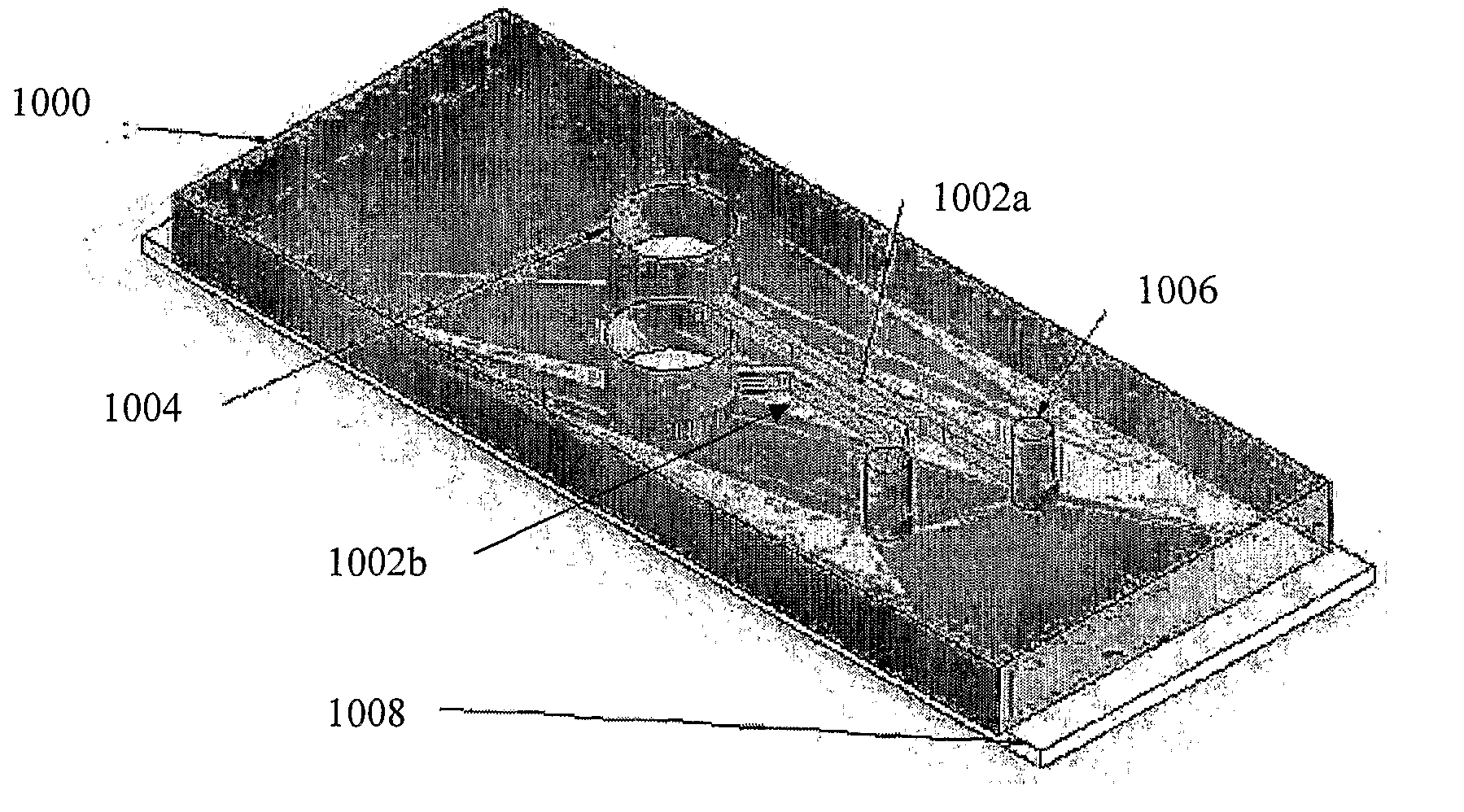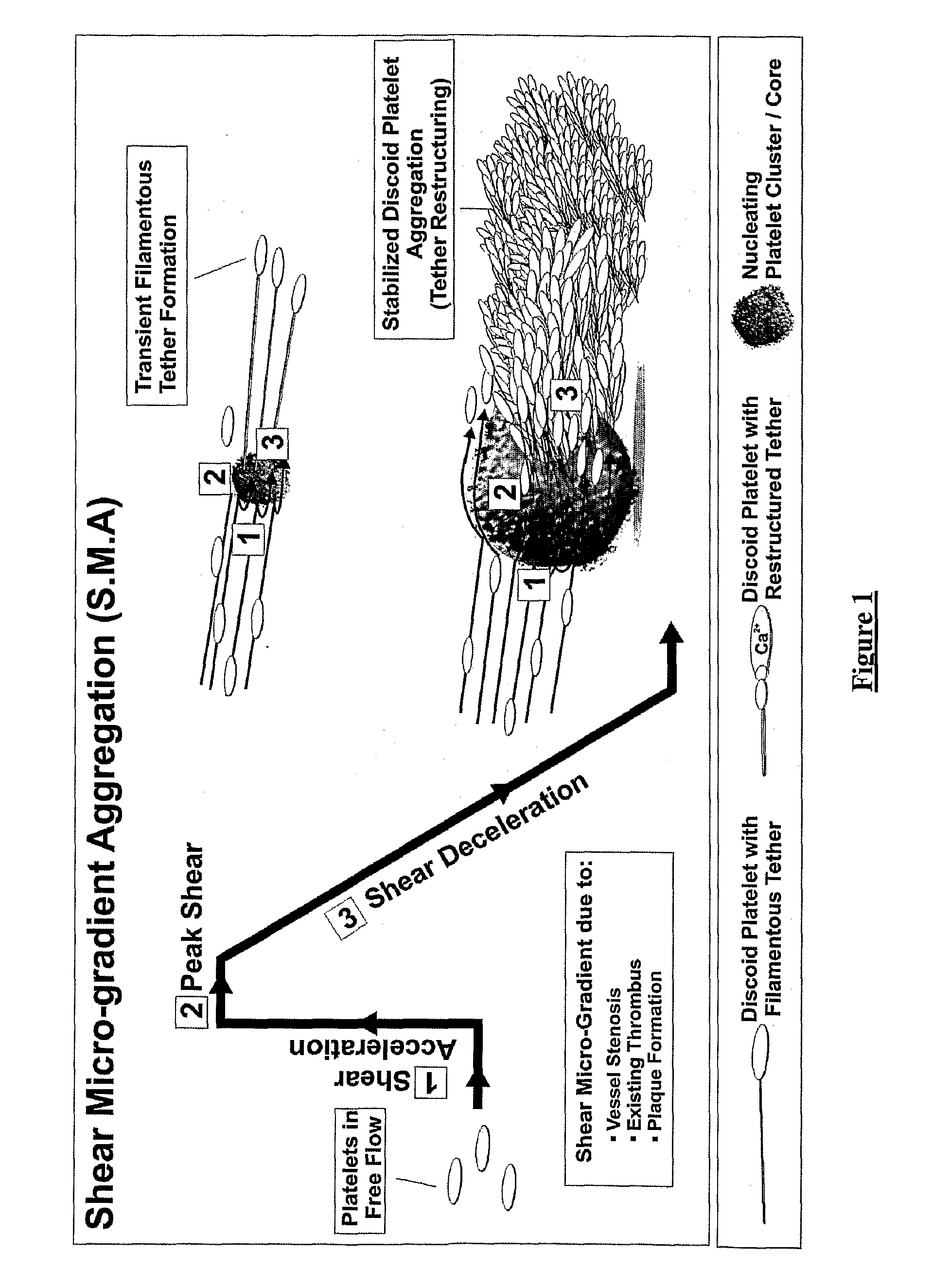Platelet aggregation using a microfluidics device
a microfluidics and platelet technology, applied in specific use bioreactors/fermenters, laboratory glassware, biomass after-treatment, etc., can solve the problems of low shear rate, tissue infarction and organ failure, vascular occlusion, etc., to facilitate the detection and observation of platelet aggregation and high throughput
- Summary
- Abstract
- Description
- Claims
- Application Information
AI Technical Summary
Benefits of technology
Problems solved by technology
Method used
Image
Examples
example 1
Blood Perfusion Through a Step Geometry
[0220]FIG. 11a is a representative micrograph (40× magnification) sequence of human (hirudin anti-coagulated) blood perfusion through a micro-shear gradient device consisting of an in-flow (entry) width of 100 μm, a contraction angle (θc) of 90°, a gap height of 10 μm, an expansion angle (θe)) of 60°, and an expansion / exit width of 700 μm. The grey arrow denotes the point of initial aggregation [t=12 sec], the black arrow designates the limit of thrombus growth in the expansion zone (representative of n=3 experiments).
[0221]FIG. 11b illustrates the results produced by computational fluid dynamics (CFD) simulation (Velocity v displacement plot) showing the velocity change for a platelet (particle) travelling 1 μm (½ discoid platelet diameter) from the surface of the micro-channel wall geometry in (a). In the case of a straight microchannel segment (1,800.s−1 laminar flow), the platelet travels at constant velocity throughout its path length. The...
example 2
Flow Rate Dependency of Two Step Geometry Iterations
[0226]FIG. 12a comprises representative aggregation traces as a function of flow rate (Q=2, 4, 6 & 8 μl / min) through a micro-shear gradient device consisting of an in-flow / entry width of 100 μm, a contraction angle (θc) of 90°, gap height of 20 μm, an expansion angle (θe) of 30°, and an expansion / exit width of 700 μm.
[0227]FIG. 12b is representative aggregation traces as a function of flow rate (Q=2, 4, 6 & 8 μl / min) through a micro-shear gradient device consisting of an in-flow width of 100 μm, a contraction angle (θc) of 90°, gap height of 20 μm, an expansion angle (θe) of 90°, and an expansion width of 700 μm.
[0228]Analysis of flow rate (Q=2, 4, 6 & 8 μl / min) dependency was examined in two step geometry configurations with expansion angles of 30° and 90° (FIGS. 12a and 12b respectively). The size of the aggregates decreased significantly with decreasing flow rate below 8μl / min in the case of both geometries. There was a decrease...
example 3
Sphere Geometry
[0229]FIG. 13a comprises DIC image frames showing the nature and extent of discoid platelet aggregation at the downstream face of VWF coated sphere geometries following whole human blood (pre-treated with 100 μM MRS2179, 10 μM 2-MeSAMP and 10 μM Indomethacin) perfusion at an applied γ of 10,000.s−1 (n=5).
[0230]FIG. 13b illustrates mean discoid platelet aggregate size (surface area in μm2) as a function of the downstream low τx,y pocket (zone 3 surface area μm2) exhibiting τ≦30.4 Pa (n=3).
[0231]FIG. 13c shows mean discoid platelet aggregate size at the downstream face of 5 μm VWF coated sphere geometries at an applied bulk γ of 10,000.s−1; Control—hirudin anticoagulated whole blood; anti-αIIbβ3—hirudin anticoagulated whole blood treated for 10 minutes with 30 μg / ml c7E3 Fab prior to blood perfusion; anti-GPIb—,hirudin anticoagulated whole blood treated for 10 minutes with 50 μg / ml of the anti-GPIb blocking IgG ALMA12 (n=3).
[0232]FIG. 13d shows the results of CFD simula...
PUM
 Login to View More
Login to View More Abstract
Description
Claims
Application Information
 Login to View More
Login to View More - R&D
- Intellectual Property
- Life Sciences
- Materials
- Tech Scout
- Unparalleled Data Quality
- Higher Quality Content
- 60% Fewer Hallucinations
Browse by: Latest US Patents, China's latest patents, Technical Efficacy Thesaurus, Application Domain, Technology Topic, Popular Technical Reports.
© 2025 PatSnap. All rights reserved.Legal|Privacy policy|Modern Slavery Act Transparency Statement|Sitemap|About US| Contact US: help@patsnap.com



